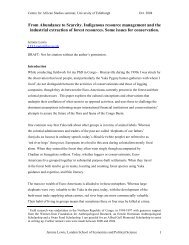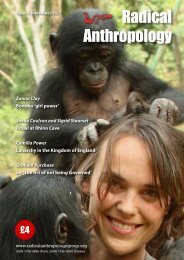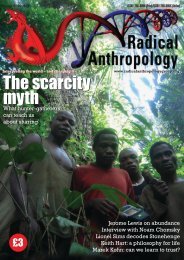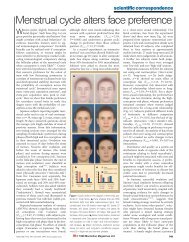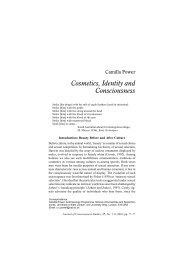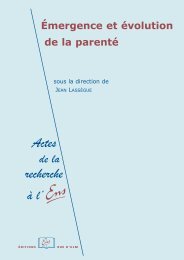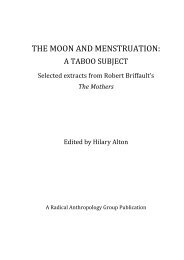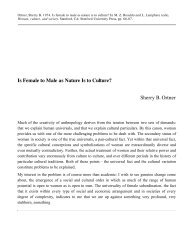Language and life history: A new perspective on the development ...
Language and life history: A new perspective on the development ...
Language and life history: A new perspective on the development ...
- No tags were found...
Create successful ePaper yourself
Turn your PDF publications into a flip-book with our unique Google optimized e-Paper software.
Commentary/Locke & Bogin: <str<strong>on</strong>g>Language</str<strong>on</strong>g> <str<strong>on</strong>g>and</str<strong>on</strong>g> <str<strong>on</strong>g>life</str<strong>on</strong>g> <str<strong>on</strong>g>history</str<strong>on</strong>g>composite system with multiple organisms, emergent supervisedlearning/teaching may be part of a larger self-organizati<strong>on</strong>al orevoluti<strong>on</strong>al paradigm.It should be emphasized that evoluti<strong>on</strong>ary <str<strong>on</strong>g>and</str<strong>on</strong>g> <strong>development</strong>al<strong>the</strong>ories of language both extend well bey<strong>on</strong>d <strong>the</strong> usual domain oflinguistics <str<strong>on</strong>g>and</str<strong>on</strong>g> linguists <str<strong>on</strong>g>and</str<strong>on</strong>g> are intrinsically multimodal. For, <strong>the</strong>sensory-motor <str<strong>on</strong>g>and</str<strong>on</strong>g> affective states of <strong>the</strong> individual <str<strong>on</strong>g>and</str<strong>on</strong>g> his peers<str<strong>on</strong>g>and</str<strong>on</strong>g> caregivers are all involved, not just in <strong>the</strong> emergence oflanguage, but in <strong>the</strong> <strong>development</strong> of a physical <str<strong>on</strong>g>and</str<strong>on</strong>g> social worldview – an <strong>on</strong>tology that encompasses our underst<str<strong>on</strong>g>and</str<strong>on</strong>g>ing ofspace <str<strong>on</strong>g>and</str<strong>on</strong>g> time, our learning to discriminate between superstitious<str<strong>on</strong>g>and</str<strong>on</strong>g> causal relati<strong>on</strong>ships, as well as our learning to affect<str<strong>on</strong>g>and</str<strong>on</strong>g> c<strong>on</strong>trol our envir<strong>on</strong>ment directly at a physical level <str<strong>on</strong>g>and</str<strong>on</strong>g>less directly through social <str<strong>on</strong>g>and</str<strong>on</strong>g> linguistic interacti<strong>on</strong>. Only in<strong>the</strong> c<strong>on</strong>text of learning <str<strong>on</strong>g>and</str<strong>on</strong>g> evoluti<strong>on</strong>ary robotics are all <strong>the</strong>sediverse aspects of evoluti<strong>on</strong>ary <str<strong>on</strong>g>and</str<strong>on</strong>g> <strong>development</strong>al <strong>the</strong>ory ableto be modelled.<str<strong>on</strong>g>Language</str<strong>on</strong>g> <str<strong>on</strong>g>and</str<strong>on</strong>g> <str<strong>on</strong>g>life</str<strong>on</strong>g> <str<strong>on</strong>g>history</str<strong>on</strong>g>: Not a <str<strong>on</strong>g>new</str<strong>on</strong>g><str<strong>on</strong>g>perspective</str<strong>on</strong>g>S<strong>on</strong>ia Ragir a <str<strong>on</strong>g>and</str<strong>on</strong>g> Patricia J. Brooks ba Department of Sociology <str<strong>on</strong>g>and</str<strong>on</strong>g> Anthropology, College of Staten Isl<str<strong>on</strong>g>and</str<strong>on</strong>g>, CityUniversity of New York, <str<strong>on</strong>g>and</str<strong>on</strong>g> American Museum of Natural History, StatenIsl<str<strong>on</strong>g>and</str<strong>on</strong>g>, NY 10314; b Department of Psychology, College of Staten Isl<str<strong>on</strong>g>and</str<strong>on</strong>g> <str<strong>on</strong>g>and</str<strong>on</strong>g>Graduate Center, City University of New York, Staten Isl<str<strong>on</strong>g>and</str<strong>on</strong>g>, NY 10314.ragir@mail.csi.cuny.eduhttp://scholar.library.csi.cuny.edu/ ragir/webpage/htmpbrooks@mail.csi.cuny.eduhttp://www.library.csi.cuny.edu/ psy/brooks.htmAbstract: The uniqueness of human cogniti<strong>on</strong> <str<strong>on</strong>g>and</str<strong>on</strong>g> language has l<strong>on</strong>gbeen linked to systematic changes in <strong>development</strong>al timing. Selecti<strong>on</strong>for postnatal skeletal ossificati<strong>on</strong> resulted in progressive prol<strong>on</strong>gati<strong>on</strong> ofuniversal patterns of primate growth, leng<strong>the</strong>ning infancy, childhood,<str<strong>on</strong>g>and</str<strong>on</strong>g> adolescence. <str<strong>on</strong>g>Language</str<strong>on</strong>g> emerged as communicati<strong>on</strong> increased incomplexity within <str<strong>on</strong>g>and</str<strong>on</strong>g> between communities ra<strong>the</strong>r than from selecti<strong>on</strong>for some unique features of childhood or adolescence, or both.From <strong>the</strong> middle of <strong>the</strong> twentieth century <strong>on</strong>ward, a scholarlyliterature has linked evoluti<strong>on</strong>ary changes in <strong>the</strong> <strong>development</strong>alprofile of hominins to terrestrial bipedalism, <strong>the</strong> narrowing of<strong>the</strong> birth canal, encephalizati<strong>on</strong>, prol<strong>on</strong>ged neocortical plasticity,behavioral flexibility, <str<strong>on</strong>g>and</str<strong>on</strong>g> profound changes in hominin socialorganizati<strong>on</strong> (e.g., de Beer 1930; 1951/1958; Eisley 1946/1957;Gould 1977; Jeris<strong>on</strong> 1973; M<strong>on</strong>tague 1962). Comparativeresearch has suggested that humans share <strong>the</strong> growth patternstypical of primates, but with a relatively greater prol<strong>on</strong>gati<strong>on</strong> ofeach <strong>development</strong>al phase than any o<strong>the</strong>r mammal of comparablesize (e.g., Finlay et al. 2001; Schultz 1960; Watts 1990). Prol<strong>on</strong>gedcell divisi<strong>on</strong> in <strong>on</strong>e phase led to delayed closure of later phases.For example, a greater number of neur<strong>on</strong>s required more timeto divide, migrate to <strong>the</strong>ir final positi<strong>on</strong>s, establish dendritic c<strong>on</strong>nectivity,<str<strong>on</strong>g>and</str<strong>on</strong>g> become myelinated (McKinney 2000). With respectto brain <strong>development</strong>, <strong>the</strong> largest perturbati<strong>on</strong> occurred in <strong>the</strong>latest developing regi<strong>on</strong>s in <strong>the</strong> neocortex, in particular, <strong>the</strong> prefr<strong>on</strong>talcortex (Deac<strong>on</strong> 1997; Finlay & Darlingt<strong>on</strong> 1995; Finlayet al. 2001). Greater numbers of cortical neur<strong>on</strong>s resulted indata compacting <str<strong>on</strong>g>and</str<strong>on</strong>g> added levels of informati<strong>on</strong> processingthat produced increasingly abstract representati<strong>on</strong>s of <strong>the</strong> compactedinput (Calvin 1996; 1998; Kien 1991). Gould (1977)argued that <strong>the</strong>se changes were systematic, <str<strong>on</strong>g>and</str<strong>on</strong>g> led to qualitativechanges in <strong>the</strong> complexity <str<strong>on</strong>g>and</str<strong>on</strong>g> automaticity of human cogniti<strong>on</strong><str<strong>on</strong>g>and</str<strong>on</strong>g> communicati<strong>on</strong>. Gould <str<strong>on</strong>g>and</str<strong>on</strong>g> Lew<strong>on</strong>tin (1979) proposed thatlanguage emerged as a by-product of general increases in brainsize, coincident with an increased need for communicati<strong>on</strong>within <str<strong>on</strong>g>and</str<strong>on</strong>g> between tightly organized primate social groups.This well-documented view of language emergence c<strong>on</strong>trastsmarkedly with Locke & Bogin’s (L&B’s) proposal of independentselecti<strong>on</strong> for aspects of language during childhood <str<strong>on</strong>g>and</str<strong>on</strong>g> adolescence.What is most surprising about <strong>the</strong>ir proposal is <strong>the</strong> suggesti<strong>on</strong>that childhood <str<strong>on</strong>g>and</str<strong>on</strong>g> adolescence are unique to humans, in <strong>the</strong>face of forty years of c<strong>on</strong>trary evidence (e.g., Harvey et al. 1987;Hobs<strong>on</strong> et al. 1981; Schultz 1969). Using skeletal <str<strong>on</strong>g>and</str<strong>on</strong>g> horm<strong>on</strong>alevidence from both m<strong>on</strong>keys <str<strong>on</strong>g>and</str<strong>on</strong>g> apes, Watts (1985; 1986;Watts & Gavan 1982) documented a distinct juvenile dependencycomparable to human childhood <str<strong>on</strong>g>and</str<strong>on</strong>g> an adolescent growth spurtthat preceded delayed sexual maturati<strong>on</strong> in all higher primates.Extended human childhood <str<strong>on</strong>g>and</str<strong>on</strong>g> adolescence appear to be c<strong>on</strong>comitantwith <strong>the</strong> systematic changes in fetal <str<strong>on</strong>g>and</str<strong>on</strong>g> postnatal <strong>development</strong>(Gould 1977; Ragir 1985; 2001a; 2001b; Shea 1990). Ifanything, given <strong>the</strong> length of childhood <str<strong>on</strong>g>and</str<strong>on</strong>g> <strong>the</strong> <str<strong>on</strong>g>life</str<strong>on</strong>g> expectancyof humans, sexual maturati<strong>on</strong> occurs relatively early as comparedto o<strong>the</strong>r apes (Shea 1990). The observed n<strong>on</strong>-uniqueness of <strong>the</strong>se<str<strong>on</strong>g>life</str<strong>on</strong>g> <str<strong>on</strong>g>history</str<strong>on</strong>g> phases is indicative of <strong>the</strong> systematic patterns ofprimate growth <str<strong>on</strong>g>and</str<strong>on</strong>g> <strong>development</strong> described above. The purporteduniqueness of human childhood <str<strong>on</strong>g>and</str<strong>on</strong>g> adolescence isseriously undermined by <strong>the</strong> similar patterns of m<strong>on</strong>key, ape,<str<strong>on</strong>g>and</str<strong>on</strong>g> human growth after infancy, <str<strong>on</strong>g>and</str<strong>on</strong>g> weak links between patternsof tooth erupti<strong>on</strong>, facial morphology, weaning <str<strong>on</strong>g>and</str<strong>on</strong>g> changingsocial-sexual <str<strong>on</strong>g>and</str<strong>on</strong>g> cognitive competence (Watts 1990).L&B’s proposal offers an unc<strong>on</strong>vincing combinati<strong>on</strong> of kin<str<strong>on</strong>g>and</str<strong>on</strong>g>sexual-selecti<strong>on</strong> pressures that operate during different <str<strong>on</strong>g>life</str<strong>on</strong>g><str<strong>on</strong>g>history</str<strong>on</strong>g> phases <str<strong>on</strong>g>and</str<strong>on</strong>g> select for seemingly dissociated competence<str<strong>on</strong>g>and</str<strong>on</strong>g> performance aspects of language. The kin-selecti<strong>on</strong> argumentfor language formati<strong>on</strong> is seriously flawed; all n<strong>on</strong>humanprimates communicate with <str<strong>on</strong>g>and</str<strong>on</strong>g> successfully raise <strong>the</strong>ir infantswithout language. <str<strong>on</strong>g>Language</str<strong>on</strong>g> between parent <str<strong>on</strong>g>and</str<strong>on</strong>g> offspringwould not necessarily improve <strong>the</strong> survival of juveniles, norensure “h<strong>on</strong>est” communicati<strong>on</strong>. Studies of emergent Sign<str<strong>on</strong>g>Language</str<strong>on</strong>g>s <str<strong>on</strong>g>and</str<strong>on</strong>g> Creoles indicate greater complexity <str<strong>on</strong>g>and</str<strong>on</strong>g> systematicityin <strong>the</strong> negotiated exchange of informati<strong>on</strong> within <str<strong>on</strong>g>and</str<strong>on</strong>g>between groups composed of relative strangers as opposed toclose kin (Kegl et al. 1999; Kend<strong>on</strong> 1980a; 1980b; 1980c;McWhorter 1997; Senghas et al. 2004; Washabaugh 1986).We also str<strong>on</strong>gly disagree with L&B’s emphasis <strong>on</strong> sexual selecti<strong>on</strong><str<strong>on</strong>g>and</str<strong>on</strong>g> <strong>the</strong> competitive aspects of language performance. Primatespractice opportunistic mating in which females fail toshow a general preference for alpha males, <str<strong>on</strong>g>and</str<strong>on</strong>g> males mate withany estrous female. Male displays of strength <str<strong>on</strong>g>and</str<strong>on</strong>g> cunning temporarilypositi<strong>on</strong> <strong>the</strong>m in a relatively unstable male dominance hierarchythat is likely to c<strong>on</strong>fer up<strong>on</strong> dominant males preferential accessto estrous females for <strong>on</strong>ly a limited part of <strong>the</strong>ir mature reproductive<str<strong>on</strong>g>life</str<strong>on</strong>g>. In c<strong>on</strong>trast, dominant females <str<strong>on</strong>g>and</str<strong>on</strong>g> <strong>the</strong>ir female kin showgreater reproductive success over <strong>the</strong> entire period of reproductivematurity (Grant 2003; Lee & Bowman 1995; van Schaik &Hrdy 1991). On <strong>the</strong> o<strong>the</strong>r h<str<strong>on</strong>g>and</str<strong>on</strong>g>, adolescence is likely to be importantin <strong>the</strong> formati<strong>on</strong> of languages for o<strong>the</strong>r reas<strong>on</strong>s; humans tend todisperse at adolescence to mate, carrying <strong>the</strong>ir local communicativepractices to nearby groups. This dispersal would promote<strong>the</strong> exchange of skills <str<strong>on</strong>g>and</str<strong>on</strong>g> informati<strong>on</strong>, exp<str<strong>on</strong>g>and</str<strong>on</strong>g> regi<strong>on</strong>al politicalaffiliati<strong>on</strong>s, <str<strong>on</strong>g>and</str<strong>on</strong>g> create mutually intelligible language dialects.Throughout <strong>the</strong> <str<strong>on</strong>g>life</str<strong>on</strong>g>span, speech performance is basic to humanlanguage, <str<strong>on</strong>g>and</str<strong>on</strong>g> adolescence is not special in this regard. <str<strong>on</strong>g>Language</str<strong>on</strong>g>use develops in t<str<strong>on</strong>g>and</str<strong>on</strong>g>em with lexic<strong>on</strong> <str<strong>on</strong>g>and</str<strong>on</strong>g> grammar, with all aspectsof language increasing in complexity in ways that reflect <str<strong>on</strong>g>and</str<strong>on</strong>g>,perhaps, implement changes in cortical organizati<strong>on</strong>. <str<strong>on</strong>g>Language</str<strong>on</strong>g>acquisiti<strong>on</strong> is possible because infants are socially c<strong>on</strong>nected <str<strong>on</strong>g>and</str<strong>on</strong>g>sensitized to <strong>the</strong> dynamics of interpers<strong>on</strong>al communicati<strong>on</strong> frombirth. Children acquire language by tuning in to <strong>the</strong> communicativeintenti<strong>on</strong>s of o<strong>the</strong>rs, through active social engagement <str<strong>on</strong>g>and</str<strong>on</strong>g>participati<strong>on</strong> in c<strong>on</strong>versati<strong>on</strong> (Tomasello 1999). Young children’spragmatic sophisticati<strong>on</strong> manifests itself in <strong>the</strong> form of social routinessuch as peek-a-boo, vocal turn taking, pointing, use ofprosody, <str<strong>on</strong>g>and</str<strong>on</strong>g> joint attenti<strong>on</strong> (e.g., Ninio & Snow 1996; Rochatet al. 1999). Children who are not segregated from adult activitiesreadily imitate <str<strong>on</strong>g>and</str<strong>on</strong>g> incorporate aspects of mature speech acts into<strong>the</strong>ir repertoires. Their pers<strong>on</strong>al narratives, sense of self, <str<strong>on</strong>g>and</str<strong>on</strong>g> autobiographicalmemory are c<strong>on</strong>structed through c<strong>on</strong>versing <str<strong>on</strong>g>and</str<strong>on</strong>g>296 BEHAVIORAL AND BRAIN SCIENCES (2006) 29:3



